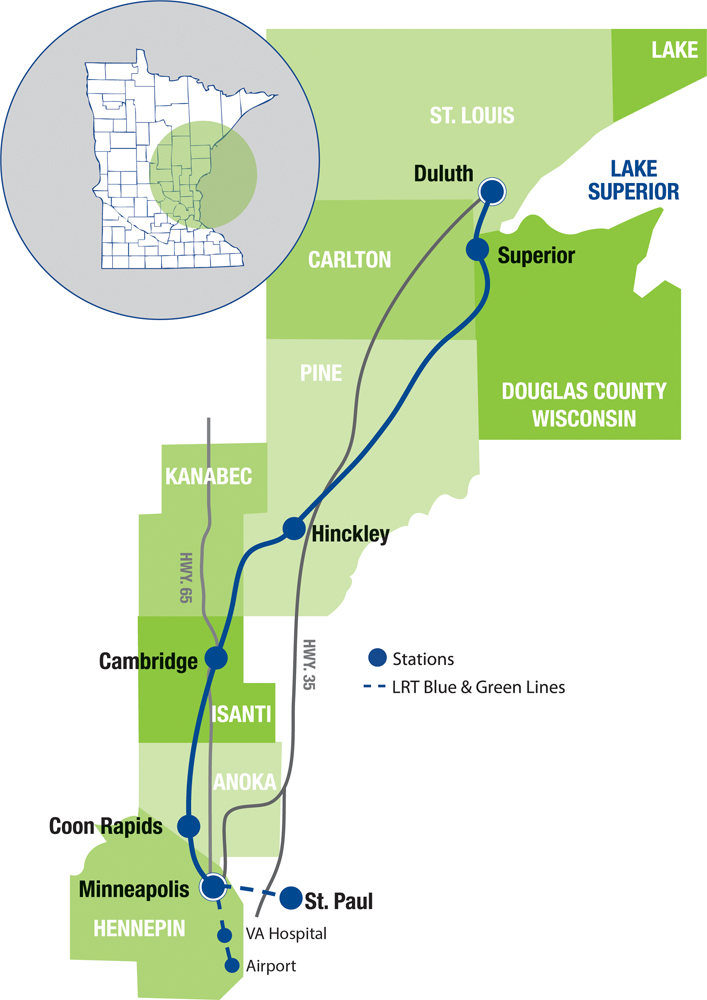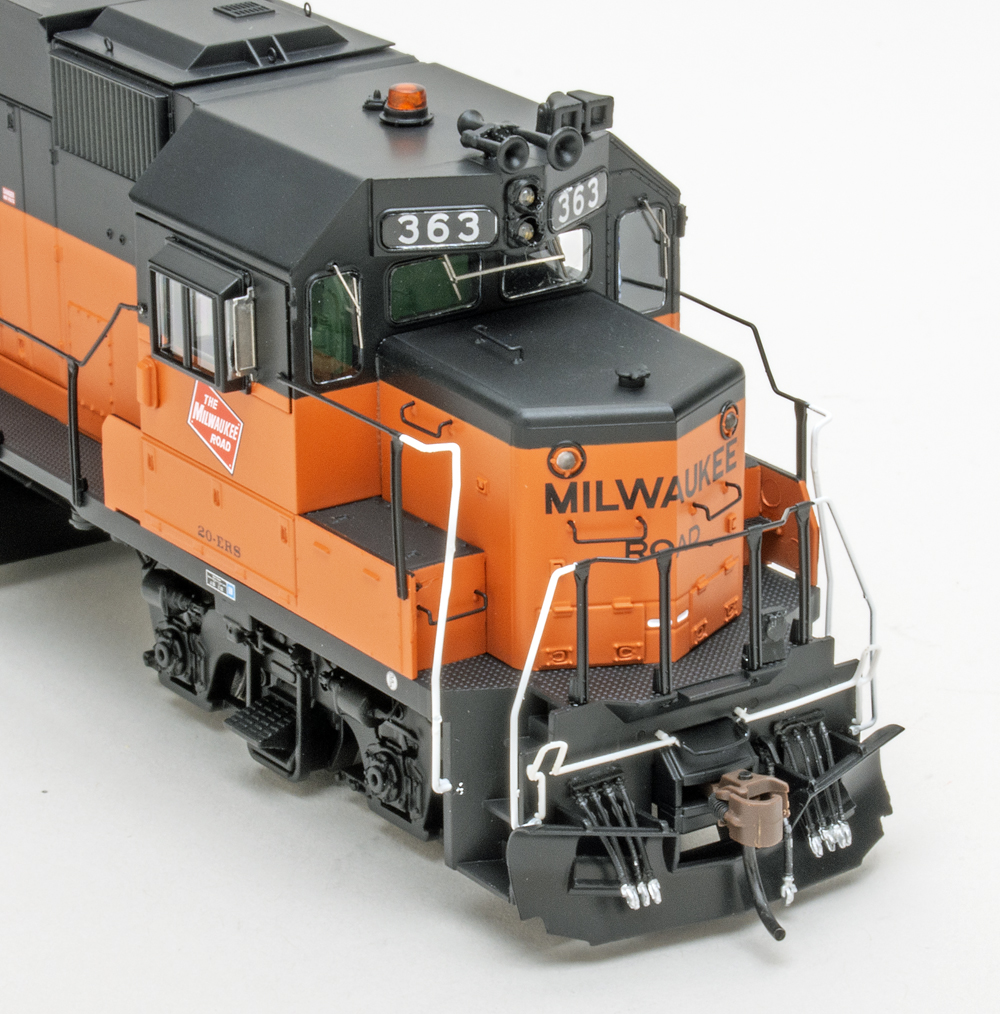
ST. PAUL, Minn. — Funding to launch passenger rail service between the Twin Cities and Duluth, Minn., has been included in transportation bills in both houses of the Minnesota legislature, although the two versions provide substantially different levels of funding.
The Duluth News Tribune reports that the budget bills prepared by both houses, controlled by a majority of Democratic-Farmer-Labor Party legislators, include funding for the Northern Lights Express. The estimate for reviving the route, last operated by Amtrak in 1985, is $450 million; the state would have to provide 20% of that total with the federal government providing the remaining 80%.
The transportation bill in the state Senate currently provides $50 million for the train — short of what is needed to unlock full federal funding — while the House version calls for $194 million, which would make almost $1 billion in total funds available. A DFL Party spokesman told the newspaper the party has a commitment to getting the train funded, and the difference will get ironed out later in a conference committee.
Supporters of the project say they are optimistic that, with both houses of the legislature and the state’s governorship all controlled by the same party, the train will finally receive funding. Republicans had opposed the train, questioning whether projected ridership and the expected 2½-hour travel time for the 152-mile trip were worth the expense.
If the train is funded, it is expected to take about three years to launch. More on the project is available here from the Minnesota Department of Transportation.














I have visited Minneapolis several times and always traveled by Amtrak. This service will add more options for both local Minnesota and out of state tourists. As noted the traffic on the interstate highways can be bad as well as those cold snowy winters. Trains can usually operate when other transportation stops and roads are relatively unsafe to drive. So this is another positive for train travel. I agree the price seems high most likely due to the need for upgraded tracks and signal systems. But the upgrades are beneficial to both passenger and freight service. So if you look at this as a long term investment it is beneficial for the state and may lead to new industrial development as well as added passenger mobility.
Just an observation – tracks will have to be replaced at Superior. Station is still there, but tracks have been removed by BNSF? Well, whoever, tracks are gone.
Startup cost is alot of$$ I believe population of St. Louis County approx 200,000 Duluth 85,000 haven’t seen much info on potential ridership numbers and the need of 4 round trips a day. State projects are always popular with local politicians when 80 percent of funding comes from the Federal government.
Would Wisconsin be obliged or willing to contribute any funding, since this train would go through a few miles of WI and stop in Superior?
We’ve supported the Hiawatha big-time, and are supporting the proposed second train to MSP. For one reason or another we haven’t succeeded in getting a train either to Madison or to the Fox Cities (Fond du Lac, Appleton, Neenah/ Menasha, Green Bay). So in answer to your question, I’d say no, Wisconsin won’t give any funding.
I would say speed is important, BUT, reliability is top of the list. You can run 150 mph but if you can’t depend on it…… And I’ve always questioned the huge startup costs. $450 million for what?
I can almost predict who will come back to complain and say “this would’ve cost $12 in 1977! and no one will ride it!” And they’re people who don’t live where the service is being planned.
It’s kind of hilarious and utterly utterly predictable.
MIKE — You’re good at prediction. You more or less predicted my posts on this article. You’re right, I don’t live in Minnesota. Other than changing planes at MSP airport I’ve been in Minnesota all of once, in 1996, for just a few hours.
What you leave out is, regardless of where I live, the issue is familiar to anyone who follows Amtrak.
I didn’t realize so many of the commenters lived in MN? I do I’d like to see the service return they have the underutilized Northstar Commuter equipment that should be an option to consider to reduce costs. Sadly as a commenter above said the political winds change & the funding gets cut which will be the case with all the new services being proposed around the country they will meet the same fate if/ when the political power shifts. Also, lets not forget the Infrastructure bill where 80% of the funding is going to Hwys adding to the deficit all because drivers didn’t want to pay their share at the pump (Bill Clinton was Pres. the last time the Fed Gas tax was increased). Oh I know but that’s different right, because that’s what you use & that make all the difference. Right???
Robert McGuire says, “Total waste of time and money.” Typical car and highway Republican. What’s wrong? 152 miles in 2 and a half hours not fast enough?
“…previous train would still be running…after 1985.” 2023 is not 1985 anymore. Much has changed and I-35 is a congested, rage-infested death trap and co$tly to maintain. Yea , you’re right – “Taxpayers need to hold onto their wallets.”
It will last 5 years. Starve for money and after an outcry the service will cease.
Total waste of time and money. If there was a need for this service, then the previous train would still be running. These things are always estimated to cost less than they eventually do and attract fewer riders than estimated. The taxpayers of Minnesota need to hold onto their wallets. I just wonder how the people of this region got around after 1985. I wonder how the 99.5% of intercity travelers who don’t ride Amtrak get around. Just wondering.
Mr. McGuire maybe if the U.S. had more opportunities for travel by train then more folks would ride. You can’t say that just because a service wasn’t needed back in 1985 then it wouldn’t be needed now. The government has wasted money on far more frivolous things than rail passenger service.
153 miles in 2.5 hours is an average speed of 60.8-mph, which is very good for Amtrak corridor services. The plan is for 4 daily roundtrips, which also not bad, but higher frequency builds ridership, a bi-hourly service would require about 8 daily trains.
You’re right, Benjamin. Frequency builds ridership, and frequency requires expensive capital investment. Speed builds ridership (to an extent) and speed is very expensive on the capital investment side. We’re singing from the same sheet of music. Even so one has to question if the ridership is there. One also has to question if that velcoity will actually be achieved.
Half a billion dollars? Really? At 5% capital recovery that’s $22.5 Million per year or $62 Thousand per day, for a service that will attract daily riders counted in the hundreds if we’re lucky. If I’m not mistaken, that’s just the capital recovery cost, not the ongoing operation deficit.
Trains just aren’t economical. And before you guys pile on about the Essential Air Service, that’s also a joke that has to be looked at. As well as local transit systems that keep getting more expensive with half the ridership of a few years ago.
The train will take three years to launch, meaning the region will have lived 41 years without the train. Has the region dried up and gone away without it?
And why three years? When Amtrak legislation was signed in 1970, we were told that all it takes to run a national passenger train service is some locomotives and cars and a handful of start-up money.
Who cares about economical, I’d rather my taxes pay for passenger rail that drone strikes on Yemeni kids.
I don’t know why you expect public transportation to make money? It shouldn’t need to. Roads for private cars don’t make money. Better we spend money on a train than war, or even farm subsidies for ethanol.
MILES — Did I say I wanted the train to make money? There’s a limit to how much I want it to cost.